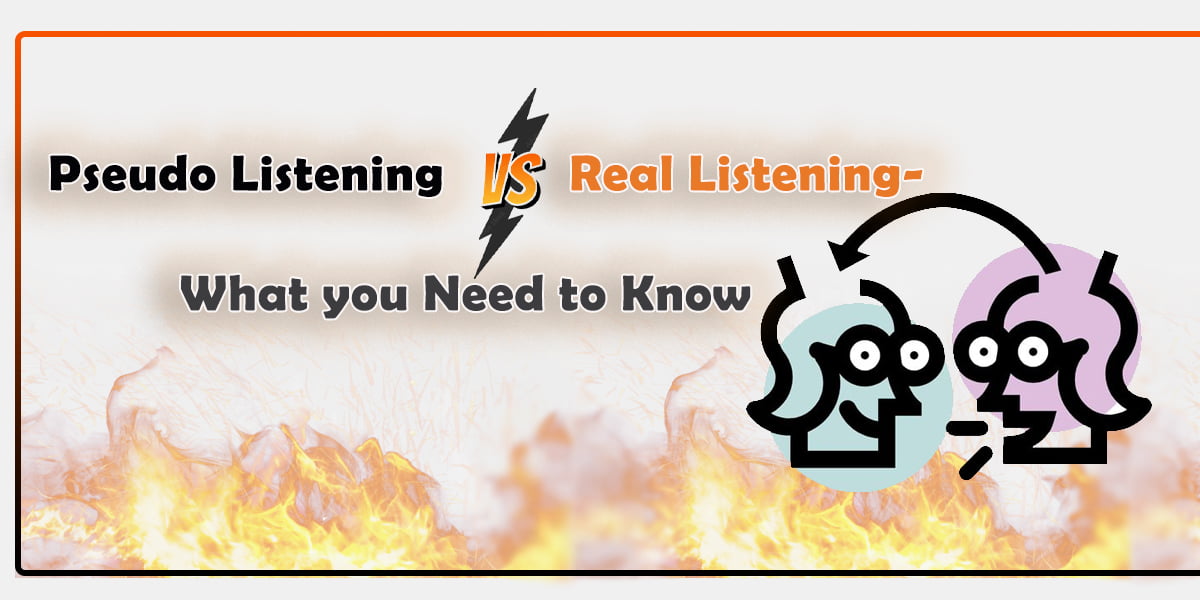It’s essential to be able to distinguish between pseudo listening and real listening, as they are two very different forms of communication. Pseudo Listener involves only listening to respond and not utterly understanding what is being said. In contrast, real listening is a more thoughtful approach to seeking profound meaning and insights. Knowing when to use pseudo listening and when to use real listening is a crucial skill for effective communication. In this article, we will explore the differences between pseudo listening and real listening and discuss what you need to know about them. This knowledge lets you choose the most proper listening method for different conversations.
Pseudo Listening
It is a term used to describe a person who appears to be actively listening but is not paying attention. Pseudo-listeners typically display behaviors such as nodding their head, making eye contact, and offering brief responses when someone else is speaking; however, they lack any real interest or understanding of what is being said. Pseudo-listeners are often seen as polite but lack proper conversation understanding. Pseudo listening can be a detriment to conversations because it discourages meaningful dialogue and hinders real communication.
Real Listening
Real listening is the opposite of pseudo. It is an active form of engagement that involves carefully paying attention to all aspects of the conversation. Real listeners are attentive to the speaker and their body language, ask questions to understand better what is being said and offer thoughtful comments that add value to the conversation. Real listening requires effort, concentration, and patience; however, it can lead to more meaningful conversations where each person feels heard and understood.
The Effects of Pseudo Listening
1. It can lead to a lack of trust in relationships: Pseudo is when one person acts like they are actively engaging with the other person but is only partially paying attention. This may cause the listener to miss critical details and be unable to offer meaningful input. As a result, it can lead to mistrust between the two parties.
2. Pseudo can cause misunderstandings: Pseudo-listening can lead to a lack of understanding on the listener’s part, which can result in confusion or resentful feelings between the two people involved. This can be especially detrimental if it repeatedly happens over time.
3. Pseudo can cause frustration: Pseudo can lead to feeling unheard or ignored, which can be very frustrating for the speaker. This can create an uncomfortable dynamic between the two parties.
4. Pseudo may lead to missed opportunities: Pseudo can lead to a lack of understanding and not being able to recognize key moments which could have been beneficial eventually. This can lead to a feeling of regret and missed opportunities.
5. Pseudo Listening can cause insecurity: Pseudo may make the speaker feel insecure, as they may not think their words are truly heard or acknowledged by the other person. This can also lead to hurt feelings and lower self-esteem.
6. Pseudo can be intimidating: Pseudo can be rough for the speaker, as they may feel like the listener is only half-listening and not actively engaging with them. This can lead to a feeling of uneasiness or discomfort in the conversation.
7. Pseudo can lead to lost productivity: Pseudo can lead to the speaker not being able to get their point across clearly, which may lead to time wasted in trying to understand each other or rehashing the same topics. This can cause a decrease in productivity overall.
8. Pseudo can lead to a feeling of disconnection: Pseudo can cause the speaker to feel like there is a lack of connection between them and the listener, leading to an overall sense of loneliness or isolation. This can also be damaging in relationships or work environments.
How to Practice Real Listening
1. Be intentional about it: remind yourself that you’re engaging in a conversation with the intent to listen, not just respond.
2. Focus on what’s being said: concentrate on the words and body language of the person speaking rather than simply waiting for your turn to talk.
3. Abandon all other distractions: put away your phone, shut down your laptop, and give the person speaking your full attention.
4. Empathize: try to understand what the speaker is saying from their perspective, even if you disagree.
5. Ask questions: engage in active listening by asking thoughtful questions that show you’re genuinely interested in what they have to say.

Benefits of practicing Real Listening
1. Increased Understanding: Practicing real listening can increase understanding between people, as it encourages active Listening where the listener is engaged with what is being said and tries to understand its meaning. This helps to create more transparent communication between people and avoid misunderstandings or confusion.
2. Improved Relationships: Practicing real listening can help to improve relationships between people, as it allows the listener to be present and attentive during conversations. This can make both parties feel heard and understood, promoting a positive connection.
3. Increased Empathy: Practicing real listening encourages one to be receptive to what is being said without passing judgment or making assumptions about the speaker. This can help to foster empathy and understanding between people, leading to more positive interactions.
4. Better Problem-Solving: Practicing real listening allows the listener to give their full attention to the speaker to understand their perspective on a problem. This can facilitate better problem-solving as both parties can come up with solutions together more flexibly.
5. Improved Self-Awareness: Practicing real listening can help increase one’s self-awareness, as it encourages the listener to be mindful of their thoughts and emotions while paying attention to what is being said without judgment. This can lead to a better understanding of oneself and one’s actions.
6. Enhanced Communication: Practicing real listening can help to enhance communication between people, as it allows the listener to be attentive and receptive to what is being said without judgment or assumptions. This can lead to more effective communication between both parties and a better understanding of each other’s needs and wants.
7. More Effective Decision-Making: Practicing real listening helps make better decisions, as it allows one to clearly understand the situation and its implications before deciding. This can lead to more informed choices that are in line with both parties’ interests.
8. Increased Clarity: Practicing real listening can help to increase clarity in conversations, as it encourages the listener to be attentive and open-minded without making assumptions. This can lead to more productive discussions and a better understanding of the subject.
Pseudo Listening or Real Listening
Regarding effective communication, pseudo listening, and real listening provide two different levels of engagement. It is a superficial process involving hearing words without further processing or considering their meaning. On the other hand, real listening encourages a more profound understanding by actively engaging in thoughtful interactions and meaningful dialogue. The critical difference between pseudo listening and real listening is that Pseudo relies on surface-level engagement. At the same time, real listening delves deeper into understanding by actively involving the listener in the conversation. Pseudo-listening often does not achieve the desired effect of mutual understanding or agreement, whereas real listening has the potential to create a beneficial outcome for both parties involved. For truly effective communication, it is essential to remember that Pseudo often falls short and real listening should always be the preferred approach. Utilizing these different listening styles ensures your conversations are meaningful and beneficial for everyone involved.
Final Thoughts
It is essential to understand the difference between pseudo listening and real listening. Pseudo can be defined as a surface-level response that does not consider the speaker’s needs. In contrast, real listening involves actively engaging with the speaker to understand their message and respond accordingly. Pseudo may lead to misunderstandings, whereas real listening ensures better communication and understanding. If we keep Pseudo and real listening in mind, it is easier for us to understand how to communicate effectively with each other. Ultimately, the goal should be to strive for better listening skills that promote clear and productive conversations.




